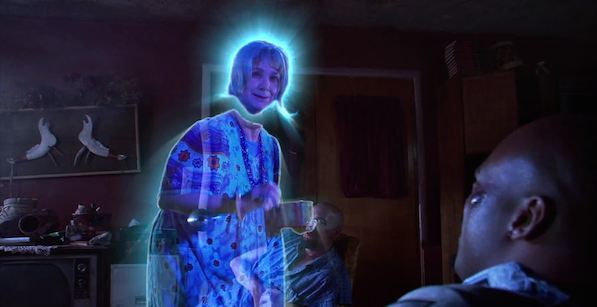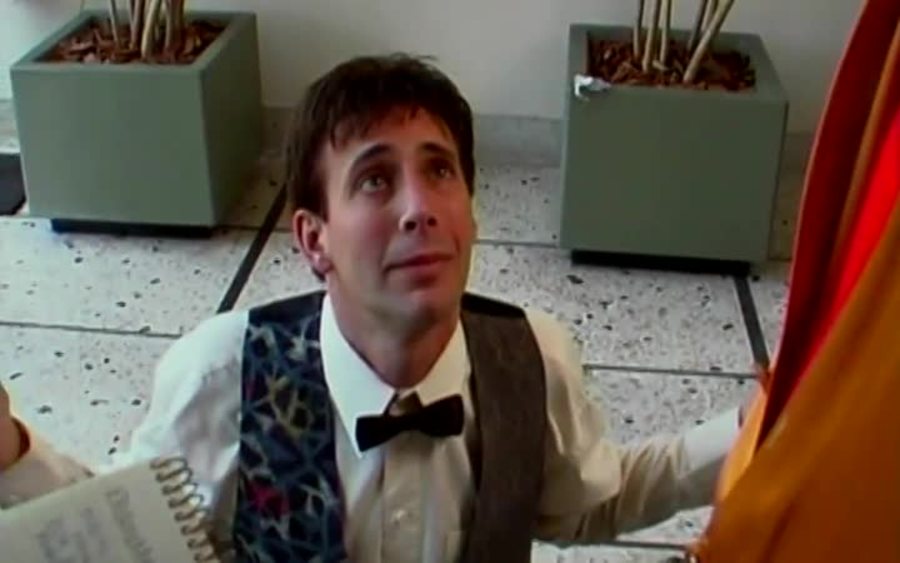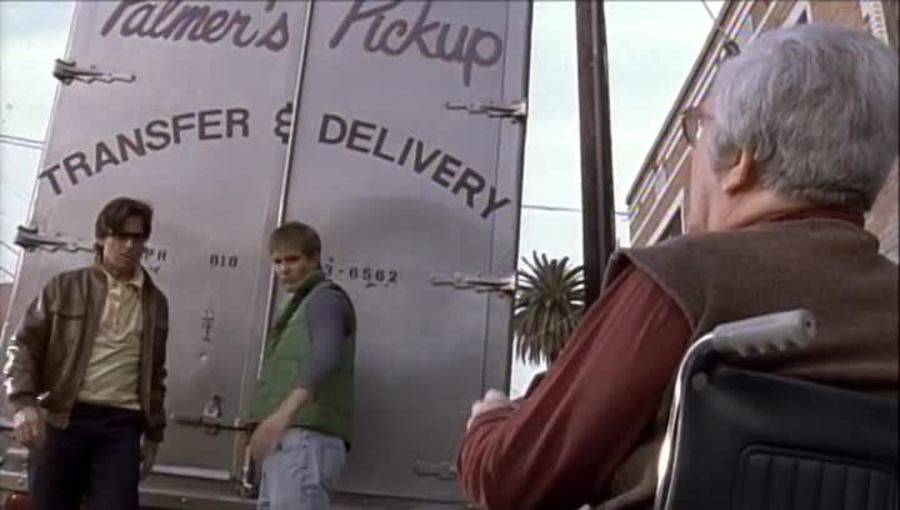A larger-than-life figure and a veritable force of nature, Christopher Coppola takes pleasure in repeating Philip Kaufman’s greeting when the venerable San Francisco director saw him on the street in North Beach: “There goes the pirate of the Coppola family.” Christopher Coppola isn’t the type to stand in anyone else’s shadow, although he’s had to get used to being identified as Francis Ford Coppola’s nephew, Sofia and Roman Coppola’s cousin and Nicolas Cage’s brother. He’s a filmmaker, above all, with several iconoclastic features to his credit and a spate of projects with titles like Sacred Blood and Biker MacBeth on various burners. An impassioned champion of digital technology and arts education, among his multitude of interests, Coppola also chairs the film department at the San Francisco Art Institute and sits on the California Arts Council. We conversed over the din in his uncle’s Café Zoetrope on a recent, rainy Thursday night before Coppola flew to Belize with his crew the next day to shoot a satirical music video.
[Many of the other Coppolas may be seen this weekend at “A Coppola Family Affair,” a benefit for the Roxie cinema in San Francisco, beginning Friday, December 19.]
Michael Fox: As a child, did you write first or did you make films first?
Christopher Coppola: I made Super 8 films with my younger brother ,who’s a famous movie star now, Nicolas Coppola, later Cage. Some of them (laughs) were actually very artistic. At age ten there was one called The Unknown Circus, which was based on Brigadoon where, at this park in the middle of suburbia, fog would roll in and in that fog would be a circus. It was a story about a clown who was jealous of a tightrope walker because the tightrope walker was getting the babe trapeze artist. Obviously my brother played the jealous clown and kills the tightrope walker. So it’s a tragedy. But what was really cool is I was pretty clever about how to get those effects, and I remember, ‘How am I going to get someone to walk on a tightrope?’ So I got a two-by-eight board and I put a thick rope on one end so the person was able to walk on the board and make it look like they were on the tightrope.
Fox: Your dad was a literature professor, yes, and I wonder if you started by putting pen to paper or, conversely, rebelled by making movies…
Coppola: He was very strict in the sense that he wanted us to know things. We would do homework for him. It was great to have a father like him because he would screen Fellini movies when we were really young and play great pieces of music like Stravinsky’s ‘Rite of Spring.’ He wanted us to read. I was actually a little, what’s the word, insecure about my writing ability. I was scared about people reading my writing, because it was very innocent, and I think part of that was that my dad was a really established professor and I was worried about him being upset about my ability. Music became my outlet. I started composing at age sixteen.
Fox: What was your instrument?
Coppola: Piano. I could play well enough to compose but, again, I was a little intimidated to play in front of an audience. I learned how to play the marimba very quickly so I would be able to perform live as college student. I did play violin when I was a kid and I won an award for playing Bach at a little festival.
Fox: How old were you?
Coppola: I think I was thirteen. My mother wasn’t well and there were some family problems, painful things affected my childhood and I said, ‘If this happens, I will quit playing violin.’ So I quit playing violin and now I am so sorry I did that. My Lord, why did I do that? I went to college early, at the University of Redlands at age sixteen to study composition with Dr. Barney Childs, who was Carlos Chavez’s and Aaron Copland’s protégé. He was a great mentor. He knew John Cage; I got to meet some great experimental composers. I was very into storytelling in my music, which is what he liked about me. The very first piece I wrote for him was called “The Jungle Quartet,” which was about my dad writing in a jungle by candlelight on his manual typewriter and it was disturbing all the animals. They were getting pissed. Then after he started writing and his thoughts were coming out clearly, the animals could hear his thoughts and it got very harmonious. They started singing to the typewriter. I had an oboe, flute and two violins tell the story. I put my score all around my dorm room and I drew words and little graphics on what each instrument was saying. All the other composition students were laughing at me because they were writing in the style of Bach. Barney said to me, ‘This is what I want to hear. This interests me.’ I wrote it and though it was very innocent you can hear exactly what I started out to do. You could hear the story. [The animals] were irritated at first and then suddenly they started getting into it. Barney loved it and said, ‘I want you to be my protégé.’ He got me out of high school because I hated high school, I didn’t take the SAT and went right to college to study with him. While studying with him I wrote quite a bit of music. I wrote an experimental opera called Plato’s Cave and a clarinet quintet about inequality. I was also a champion fencer—both foil and sabre—and used my street smarts to win battles. I would charge and scream [during fencing matches] and that would freak my opponents out, and I’d get my touché point. I learned how to break my opponent’s sword using the coupe and use that for me final touché point. The sword cost $200 so if it broke it would temporarily stun the opponent and you’d get your stab in. The problem was if they didn’t freak out, then you have a really sharp sword point coming at you because of the broken tip.
Fox: You put the camera down for this whole period?
Coppola: Yeah, I put the camera down from fifteen to eighteen. As a kid, I liked to listen to Alexander Scriabin, the Russian who composed the symphonic tone poem ‘Ecstasy,’ where he actually had emotional abstract color projections over the symphony orchestra. I liked that piece, so I said, ‘I’m going to shoot some Super 8 again, but it’ll be very abstract, and we’ll project it and our University of Redlands New Music ensemble will interpret the images and perform to it. Like the great David Tudor did for the great John Cage.
Fox: I gather that you got more interested in filmmaking when you transferred to the S.F. Art Institute.
Coppola: I was yearning to do experimental filmmaking with my music so going to SFAI was a natural progression. I loved the concept of seeing music, hearing film. I also started reading Rimbaud and the early German romantics like Novalis and E.T.A. Hoffmann. I mentioned I wrote an experimental opera on “Plato’s Cave” about being blinded by the bright light of truth but while at SFAI, I started feeling like even if you’re inside the shadows, if you believe in it, it can still be true to you. I started experimenting with films that told a different story of Plato. Even if you’re a prisoner in a cave, and you believe those shadows are real, there’s no reason why you can’t become an individual, that you have to be blinded by Plato’s truth. What was consistent in my creative process, either music or film, was that I always started with a philosophical question or poetic story like I did with “Jungle Quartet.” I remember [animator] Larry Jordan, who I [took] a class with, said, “What’s interesting abut Christopher is that he has clarity of vision. He tells you what he’s set out to do, we look at it, and he did it.’ I’ve always taken that to heart, even with my film students at SFAI. “What I’m going to teach you—and I don’t care if it’s found footage or whatever you do—you need to tell me what your reasons are, what your original idea is. And then we’ll look at it, and we’ll talk about how close it was or why it’s different [from the original idea].’ I believe this is important for an artist to be able to do.
Fox: I’m getting the impression, and I wasn’t expecting this, that you are comfortable combining high and low culture. Do you find that assessment insulting?
Coppola: Not at all. I was an extremely pretentious little kid. I had very few friends. If you didn’t know who Bartok was I didn’t have time for you. I didn’t start coming out of my pretentious snooty artist shell until I was twenty-one. I allowed some pop culture to come in to my life. And when I say pop I’m talking the Beatles, who are obviously way more than pop. Funny thing is I loved The Monkees as a kid, but I also loved Bartok and Stravinsky. I guess The Monkees would be considered pretty low culture. I liked Mickey Dolenz; he was an idol of mine. I remember I thought I looked like him and that was cool. So while I was studying the late Beethoven string quartets, I was studying Mickey Dolenz. I also loved Clint Eastwood in the Spaghetti Westerns when he would walk out with the poncho and the dynamite cloud blowing in the wind behind him. So, yes, I guess I had a very healthy high- and low-brow muscle thing going on. The older I got the more I disliked highbrow exclusiveness. I loved the drive-in movies. I would see great flicks like the Attack of the Giant Leeches and the original Deathrace 2000. So studying with the legendary George Kuchar at SFAI was a perfect fit for me.
Fox: And he was also very smart and very sophisticated.
Coppola: Yeah, but a lot of people consider it low art. It draws from those drive-in movies and over-the-top Hollywood glamour. He’s an excellent actor as well. Loved him Curt McDowell’s movies–
Fox: Thundercrack!
Coppola: Thundercrack! Yes, a highbrow/lowbrow masterpiece. I was still pretty pretentious though when I graduated from SFAI. When I got out of school I was offered a film by Dino De Laurentiis called Dracula’s Widow [released in 1988]. It was my first feature film—
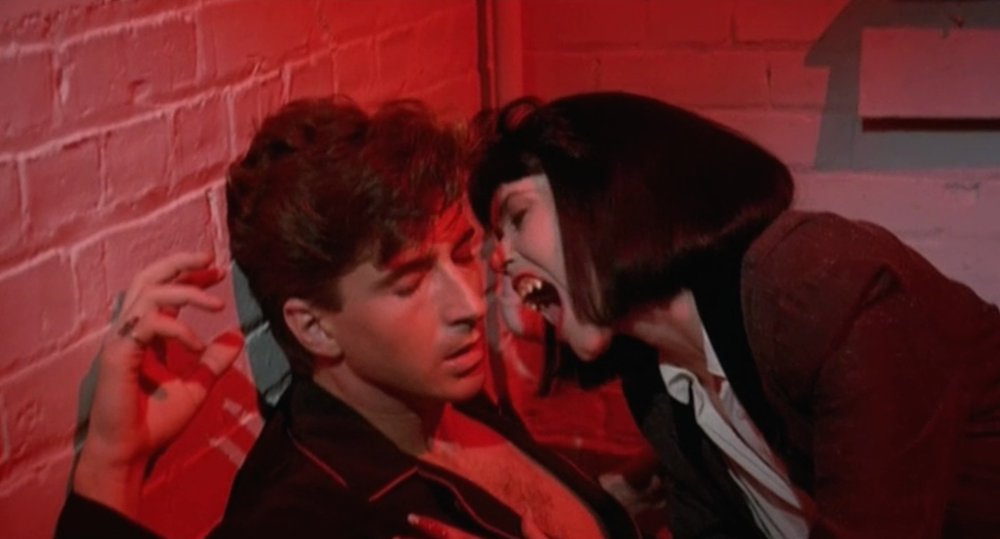
Fox: Did you shoot it in North Carolina, where De Laurentiis built a studio in the 1980s?
Coppola: North Carolina, yes. I had Giuseppe Maccari [as cinematographer], who was Fellini’s camera operator. Like I said, I was still kind of a film snob; I could tell you anything about Bergman and Truffaut. Maccari was also a painter and liked working with me because I had all these ideas about the use of color and was drawing from Goethe’s Book of Color. At the same time, this was a drive-in lowbrow vampire film starring soft porn icon Sylvia Kristel, but I wanted to bring art to it because I came out of art school. Dino De Laurentiis said, ‘I just want watermelons.’ I didn’t know what the hell he was talking about; basically it was big tits. I was horrified. ‘You’re telling me to give you big tits.’ He’s like, ‘What else is there?’ I didn’t have the perfect balance of highbrow, lowbrow perception yet. There was one moment where I said, ‘Give me the set to myself.’ The crew left. I needed to prepare for the scene in which a nude stripper is chained on a stretch rack and devil-worshipping maniacs sacrifice her. Then Sylvia Kristel shows up, turns into an ugly monster and slashes them all to pieces. Alone, I sprayed walls with fake blood and threw hamburger meat everywhere. I was trying to get into it but I was very depressed. I am an artist not a meat thrower. As I got older, I got it. You want watermelons? I’ll give you watermelons. You give me my art stuff, I’ll give you your watermelon stuff. That’s the lowbrow-highbrow dance. Now, I don’t judge Dino De Laurentiis. I get it. I understand why he wants his watermelons. And actually, if I was in his position, I’d probably ask for watermelons, too.
Fox: And yet in the ensuing years you’ve largely succeeded in retaining your artistic vision and resisting compromises.
Coppola: Yes, I have to be me regardless. My films are hard to put into any classification. I guess the same could be said about me. My flick might be classified as a lowbrow drive-in movie but yet there’s something being said. It’s funny and at the same time it’s not funny. I don’t know why. That’s just the way I see things. Maybe that’s not the best for commercial filmmaking, but I notice as time goes on that there’s a cult aspect to [my films]. Some people reinvestigate, revisit it. The one film of mine I would say that’s not true is Deadfall (1993). That’s my least favorite movie. It’s a terrible thing to say but I’m sorry I made it. It was a situation where I pulled in all my contacts; it was a $15 million movie, I had all these great actors, and at the last minute Val Kilmer walked, even though he broke the contract. I wasn’t the producer, I was just the director, and it was like a death. I had all these people in my crew from New York wondering what the hell was going on. I had big-name actors with pay-or-play deals, big chunks of money. It was a total disaster.
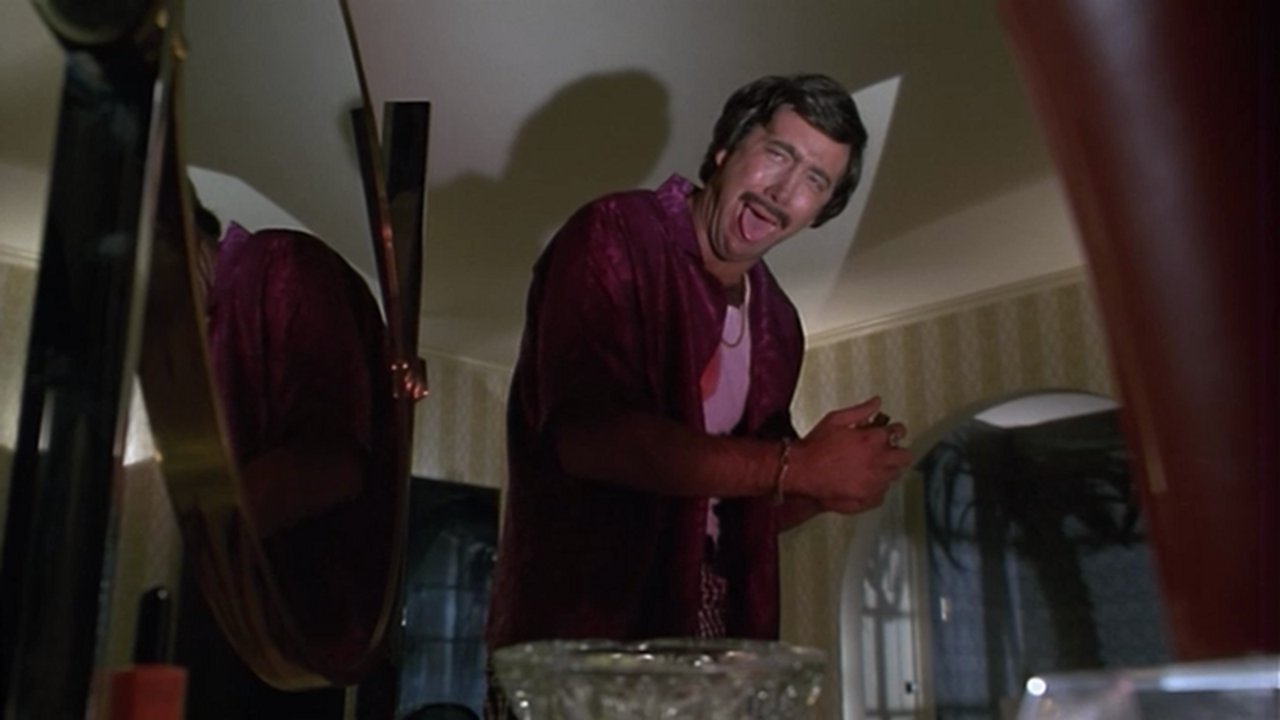
Fox: I suppose there was a valuable lesson in there somewhere.
Coppola: I guess so. I was ostracized. ‘Deadfall? You mean Dreadful.’ Or ‘Here’s a Coppola that makes crap. I remember the horrible premiere—it was cool, though, Clint Eastwood left a message, ‘I’m not going to be able to go to your premiere but wish you well’—and they had a double-printed scene in the print. The print I saw didn’t have the mistake but the one that was shown at the premiere did. There’s this awkward sex scene, and then it plays again. The lab made a mistake. Trimark didn’t check it. It was a disastrous premiere. My lawyer said, ‘Lay low, Christopher, lay low for two years.’ I did, and I started my own company, Plaster City Productions, Inc. I made a film for Francis based on Hopalong Cassidy called Bar 23, low budget, and then I changed the name to The Ballad of a Gunfighter and it sat on a shelf for ten years. Ten years go by and I said, ‘I cannot have a film that isn’t finished.’ So I raised the money and I finished it, with Bobby Carradine and Martin Sheen in it, and it made some money. I didn’t get anything, but at least it’s out. Everything I’ve ever set out to do I’ve finished.
Fox: This leads us to the three films streaming here, beginning with Palmer’s Pick-up (1999). Would it be fair to advise viewers that, with your depth of exposure to and affinity for high and low culture, they’ll get some but not all of your references?
Coppola: It’s a circus, particularly the American circus. In the American circus there are three rings, and there’s something different going on in each ring. Each member of the audience saw something different. When they went home they would talk about what they saw, and the circus would live on. I always liked that kind of everything-happening-at-once art. Charles Ives is a big hero of mine. His father would have two marching bands coming at each other, playing different music (highbrow, lowbrow maybe?). Ives Jr. would watch and listen from the middle of the street exactly where the bands passed each other. He learned to hear the notes between the notes. I like to see myself as Ives Sr. doing wacky experiments that lead to someone else’s new art.
Fox: Everybody gets their own experience. And they get what they get.
Coppola: They can like it or hate it, but they get something. And there is an experience there. I’ve always been into the sacred and profane. I have a picture of nuns playing pool. I love that picture. I’m that kind of guy. There’s a reason for that, I don’t know exactly what it is but I can’t live without the other.
Fox: What do you remember about Palmer’s Pick-up?
Coppola; I’ll tell you a funny story about Palmer’s Pick-up, when it premiered at the Berlin Film Festival. My brother was there with 8MM, I was there with Palmer’s Pick-up. This was 1999 and Palmer’s Pick-up takes place during the millennial change. I was into that because everyone was talking about how the world was going to end and I loved It’s a Mad, Mad, Mad, Mad World (1963), so I wanted to make a futuristic, modern-day It’s a Mad, Mad, Mad, Mad World about suburbia and everyday people who have the world in their hands. The night before the Berlin premiere I walked the streets to take my mind off of things. I also like to do a little social investigation, the Berlin Wall was also down. I’m walking the streets and I’m wearing a fluorescent orange turtleneck with a silky gold dress shirt over it. I’m not as showy now. I went to East Berlin and I went into a bar. It was like an old barracks with razor wire but it was a bar. It was a scene. There were Eritreans and Ethiopians at the bar arguing about who’s country was better. I bought them drinks then grabbed both of them—and these guys are bigger than me—and force them towards a photo booth in the corner. I wanted a ‘solidarity’/’all in this together’ photo booth snapshot with them. Needless to say, they wouldn’t take the picture with me and threw me into the wall. I had a gash on my face and didn’t realize it. I said, ‘Friends, we get a free Berlin Film Festival breakfast in the morning, come back and have some breakfast with me.’ I’m completely gone. People who know me say, ‘Your movies are in some ways more interesting to work on than seeing them,’ because of the oddness of my adventures and my creative process. That’s me. What you see is me, in many ways. Often wacky, but with a lot of heart.
Anyhow, [at the hotel] I wake up to my writing partner Nick Johnson whispering, ‘Christopher, you’ve got dried blood all over your shirt and your head.’ I look around and everybody is way over across the room sitting at those community breakfast tables. Not sitting at my table. I said, ‘Oh my God, I’m so sorry.’ ‘No, this is good. We’re going to have a full house tonight. Everybody is looking at you, they know you’re Nic Cage’s older brother, they know you’re here with this movie and they’re all very curious.’ We had a full house. That kind of fits, you know what I mean?
Fox: You made Bel Air that same year.
Coppola: Here’s why I made Bel Air: When I was doing Palmer’s Pick-up, it was a total adventure. We drove across country with a very small crew and Bobby Carradine, Richard Hillman—the young Pearl, who’s a terrific actor—and we had the two bad guys Patrick Kilpatrick and Neil Giuntoli. God, I’m surprised I remember their names. (Laughs.) We all went across the country together and it was El Nino. Horizontal rain. We dealt with it all. It was an adventure. Full adventure.
[At this point, Coppola launches into a long story about the accidental destruction and resurrection of the Palmer’s Pick-up negative. This painful episode led to his decision to shoot Bel Air on digital.]
Coppola: I said, ‘You know what, let’s make a slate of digital films. Low budget, give people an opportunity.’ I made this film for under $40,000, it was my anti-Hollywood film. Bel Air was to be the first of the Digiflick slate. Back then digital video looked, well, very digital video. I said, ‘Let’s embrace the look. I wanted a museum-like lighting style, specimen lighting. Bel Air questions being something you’re not, living in this fake world and gradually morphing like a picture of Dorian Gray. You’re living something you shouldn’t be living, being dishonest with yourself. I did this film to partly experiment with micro budget digital filmmaking and partly to tell a story about what happens if you want something so bad and you’re willing to sell out for it.
I had this great Korean make-up lady who wanted to do special make-up effects. So I said ‘Let’s do boils. Make our lead character’s face gradually become hideous and nobody notices. Only once in a while they notice.’ So that’s where maybe the lowbrow comes in, the scary monster stuff. His face is morphing, his hair is coming out but nobody says anything—except his girlfriend, who used to care for him before he shacked up with a rich eighty-year-old Emmy award-winning woman television producer that he has to have anal sex with to get his career back. It’s an interesting story. (Laughs.)
Fox: And students would work on these films as well?
Coppola: Yeah, side by side with professionals. I see my Digiflick slate a lot like the Roger Corman format. That is important to me. Even though these are low-budget genre flicks they will start again with an idea, a question or thought. The kernel of thought behind The Creature of the Sunny Side Up Trailer Park, which is now called The Cult of the Evil Geezers, was you never know what’s inside a monster. So that’s our starting premise. It’s about anti-racism. It’s about how racists are little children, too. They’re not born monsters. It’s ignorance. It’s about the fact that you can be black or white, it’s all the same on the inside. It’s about the fact that I want to make a rubber monster movie, and I like this tagline: ‘Two brothers. Two colors. One nightmare.’ I also want there to be a trailer park in the desert, because I love the desert. And I want Frank Gorshin in it. Then I want my wife [Adrienne Stout] to write the first draft because she writes children’s books and likes Thomas the Tank Engine. In a nutshell I wanted to shoot through an anti-racist, rubber monster, drive-in movie, childlike lens. I believe I succeeded.
Fox: The Cult of the Evil Geezers played the Cinequest festival in San Jose and a few places outside of the U.S., but it’s essentially a discovery for viewers.
Coppola: For anybody in America, especially those who worked on it.
Fox: That’s exciting as hell.
Coppola; It’s very exciting. But what I like about it is when I got my film back I wanted to do my first online release. Again, I’m known for being the DigiVangelist, and I know on-line distribution is going to get bigger and bigger.

